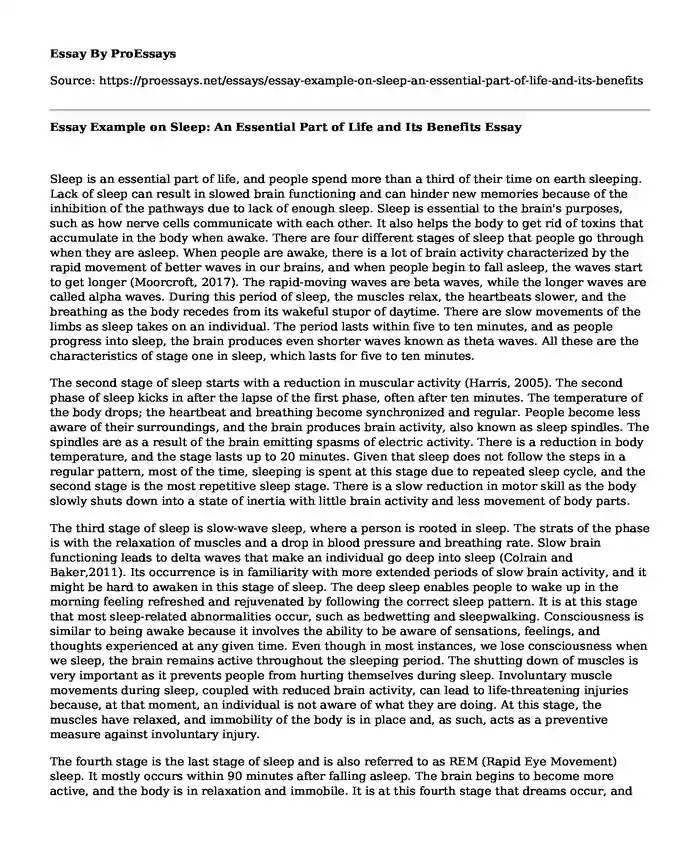Sleep is an essential part of life, and people spend more than a third of their time on earth sleeping. Lack of sleep can result in slowed brain functioning and can hinder new memories because of the inhibition of the pathways due to lack of enough sleep. Sleep is essential to the brain's purposes, such as how nerve cells communicate with each other. It also helps the body to get rid of toxins that accumulate in the body when awake. There are four different stages of sleep that people go through when they are asleep. When people are awake, there is a lot of brain activity characterized by the rapid movement of better waves in our brains, and when people begin to fall asleep, the waves start to get longer (Moorcroft, 2017). The rapid-moving waves are beta waves, while the longer waves are called alpha waves. During this period of sleep, the muscles relax, the heartbeats slower, and the breathing as the body recedes from its wakeful stupor of daytime. There are slow movements of the limbs as sleep takes on an individual. The period lasts within five to ten minutes, and as people progress into sleep, the brain produces even shorter waves known as theta waves. All these are the characteristics of stage one in sleep, which lasts for five to ten minutes.
The second stage of sleep starts with a reduction in muscular activity (Harris, 2005). The second phase of sleep kicks in after the lapse of the first phase, often after ten minutes. The temperature of the body drops; the heartbeat and breathing become synchronized and regular. People become less aware of their surroundings, and the brain produces brain activity, also known as sleep spindles. The spindles are as a result of the brain emitting spasms of electric activity. There is a reduction in body temperature, and the stage lasts up to 20 minutes. Given that sleep does not follow the steps in a regular pattern, most of the time, sleeping is spent at this stage due to repeated sleep cycle, and the second stage is the most repetitive sleep stage. There is a slow reduction in motor skill as the body slowly shuts down into a state of inertia with little brain activity and less movement of body parts.
The third stage of sleep is slow-wave sleep, where a person is rooted in sleep. The strats of the phase is with the relaxation of muscles and a drop in blood pressure and breathing rate. Slow brain functioning leads to delta waves that make an individual go deep into sleep (Colrain and Baker,2011). Its occurrence is in familiarity with more extended periods of slow brain activity, and it might be hard to awaken in this stage of sleep. The deep sleep enables people to wake up in the morning feeling refreshed and rejuvenated by following the correct sleep pattern. It is at this stage that most sleep-related abnormalities occur, such as bedwetting and sleepwalking. Consciousness is similar to being awake because it involves the ability to be aware of sensations, feelings, and thoughts experienced at any given time. Even though in most instances, we lose consciousness when we sleep, the brain remains active throughout the sleeping period. The shutting down of muscles is very important as it prevents people from hurting themselves during sleep. Involuntary muscle movements during sleep, coupled with reduced brain activity, can lead to life-threatening injuries because, at that moment, an individual is not aware of what they are doing. At this stage, the muscles have relaxed, and immobility of the body is in place and, as such, acts as a preventive measure against involuntary injury.
The fourth stage is the last stage of sleep and is also referred to as REM (Rapid Eye Movement) sleep. It mostly occurs within 90 minutes after falling asleep. The brain begins to become more active, and the body is in relaxation and immobile. It is at this fourth stage that dreams occur, and there is a rapid movement of the eyes (Walcutt, 2009). Sleep does not move in order of the steps but starts again after the second and third stages; it is repeated before an individual enters the fourth stage. The fourth stage is similar to being awake because blood pressure increases to levels where it's more comfortable to wake up. And as age advances, people sleep less in this stage of sleep. Therefore, it is easier to wake an individual at this stage due to the increase in brain activity.
References
Colrain, I. M., & Baker, F. C. (2011). Changes in sleep as a function of adolescent development. Neuropsychology review, 21(1), 5-21.
Harris, C. D. (2005). Neurophysiology of sleep and wakefulness. Respiratory care clinics of North America, 11(4), 567.
Moorcroft, W. H. (2017). An overview of sleep. In Sleep and Dreams (pp. 3-29). Routledge.
Walcutt, D. L. (2009). Stages of sleep. Psych Central-Trusted mental health, depression, bipolar, ADHD & psychology information, 1995-2018.
Cite this page
Essay Example on Sleep: An Essential Part of Life and Its Benefits. (2023, Sep 25). Retrieved from https://proessays.net/essays/essay-example-on-sleep-an-essential-part-of-life-and-its-benefits
If you are the original author of this essay and no longer wish to have it published on the ProEssays website, please click below to request its removal:
- STD at an Alarming Rate of Adults Paper Example
- Nursing and Surgery - Questions and Answers Essay
- Essay Sample on Emergency Management: Saving Lives & Limiting Disaster Costs
- Essay Example on Public Policy: Authoritative Action to Deal With Social Problems
- COVID-19 Pandemic: Disrupting Education Systems and Vaccine Trials - Essay Sample
- COVID-19: Strategies for Preparing for Pandemic Outbreaks in Chicago - Essay Sample
- Essay on Revolutionizing Perioperative Nursing: Integrating Smart Hospital Technologies for Enhanced Patient Care







